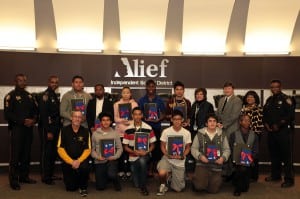
There is no question that students who stay in school have better odds of being successful and having a positive impact on their communities. According to Houston nonprofit Communities in Schools, 51% of students in the Houston Area fail to graduate within four years of entering high school. In addition, 25% of the dropout population age 25 and over lives below the poverty line, and dropouts account for a disproportionately higher percentage of Texas prison and death row inmates.
To encourage students to stay in school, CITGO Petroleum partnered with the Harris County Sheriff’s Office to launch the “Kindling Young Minds” program across six Houston high schools spanning three independent school districts (ISDs).
CITGO and the Sheriff’s office decided to work with the Alief, Houston and Spring Branch Independent School Districts. Each ISD then selected two schools with a high rates of absenteeism to benefit from the inaugural program.
The participating schools identified students who have demonstrated either perfect or improved attendance for the semester. Each of the six schools then randomly selected five students each semester to receive a Kindle Fire tablet. A total of 60 tablets were distributed during the 2013-2014 school year.
CONSISTENT THEME
Both CITGO and the Sheriff’s office have a history of supporting education, including through scholarship programs.
The “Kindling Young Minds” program provided a different way to incentivize students. It also gave the two sponsor organizations an opportunity to work together toward shared commitments—in this case, education and student success.
To generate media coverage for the campaign, the school districts, the Sheriff’s office and CITGO worked together to develop messages so that while each organization leveraged its own well-established contacts there would be one consistent theme no matter which organization was speaking. The campaign launched with a press release in December 2013 to announce the 30 winners from the first semester.
The release was supported by media outreach and social media posts among all the various sponsors as well as on-campus events at all six schools.
LEVICK, the agency of record for CITGO, worked with the CITGO corporate office, the schools and the Sheriff’s office to draft the news release, develop talking points and pitch the release.
Once the second semester winners were chosen (last May), another press release was issued and supported again through media outreach and social media activity.
Between December 2013 and May 2014, the campaign generated more than 660 placements, reaching an audience of nearly 147 million including coverage on local television.
While CITGO and the Sheriff’s department were thrilled with the number of placements, that was not the real measure of success.

LIGHTING A FIRE
The greater achievement is the enthusiasm from the students, as reported by Patrick Cherry, principal at Hastings High School in the Alief ISD. “The ‘Kindling Young Minds’ program has proven to be an excellent way to motivate our students to strive for improved attendance,” he said.
He added: “The Kindle Fire tablets help students complete schoolwork at home or on the go, and the partnership with CITGO and HCSO has been a true win-win for the kids and the schools. Our students love technology and we are thankful that we can provide them with tools that help them learn and support their academic achievement.”
The Spring Branch ISD reported that attendance rates for 2013-2014 at the two schools that participated rose, compared with the 2012-2013 school year, although with all the factors that go into attendance it was impossible to credit that change entirely to the CITGO program.
Nevertheless, it was clear that the “Kindling Young Minds” program was fully responsible for the reactions of the students in the presentations.
Spring Branch staff said that it was incredibly rewarding to watch the faces of the students who were thrilled by being recognized.
Several of them remarked about how proud their parents would be, not only because they won the Kindle Fire, but also simply for being singled out as students who did something positive. Administrators saw even more enthusiasm for the spring semester—the second phase of the program—after the excitement of the prizes being awarded to the first semester winners in December.
The prize presentations were more than just a way to distribute the Kindles. They also provided a chance for the students to interact with professionals from the Sheriff’s department and from CITGO.
Many of these students don’t have a lot of mentors and professional role models, so being told by Sheriff Adrian Garcia that investing in schools and students was important to his department and that they had a better path forward if they stayed in school resonated with the students.
Understanding that people care about them—people beyond their immediate family—made the students feel special.
STRONGER BONDS
For several of the students, the Kindle Fires will also make a big difference for their entire families.
In particular, Northbrook High School in the Spring Branch ISD has many lower income students who wouldn’t otherwise be able to afford a tablet. Winning students will have the computers not only for their own schoolwork but also to share with their families.
The “Kindling Young Minds” program succeeded on many levels in its first year. The program generated excitement at the participating schools for good attendance and also provided positive reinforcement for the winning students.
It allowed the students to have positive interactions with role models and mentors outside of the school system. And it helped build stronger relationships between CITGO and the Sheriff’s department and local schools.
In fact, CITGO and the Sheriff’s department are working together on more programs, kindling more than just young minds.
5 PR Tips for Building Strategic Partnerships

▶ Know what issues are important to your organization. For CITGO Petroleum, education has always been one of the company’s core social pillars and a focus of its social responsibility investments. Building a program like “Kindling Young Minds” allowed the company to focus on the power of staying in school and how students who stay in school are better equipped to make positive contributions to their communities later in life.
▶ Identify other organizations that share similar goals. In this case it was the Harris County Sheriff’s Department, CITGO Petroleum and the three Independent School Districts that all wanted to help get students excited about attending school. In Houston, education is an important issue across the city.
▶ Commit to a pilot program. It’s wise to start with an initial commitment to test the idea. That pilot program can grow and expand into an annual campaign. There were a lot of considerations that went into the guidelines for the CITGO program. For example, it was important to reward not just perfect attendance but also improved attendance, and the schools saw the success of the program grow in the second semester.
▶ Define what success looks like. For the “Kindling Young Minds” program, success was measured in the student attendance numbers and in more intangible ways relating to pride and enthusiasm in the students as well as in improved communications among the partner organizations.
▶ Promote the campaign through multiple channels. Traditional channels (such as press releases) were used to promote the awarding of the Kindles each semester. The schools used student assemblies and other methods to promote the program with students and teachers. Social media channels may be more engaged in future campaigns. —M.A.
(This article was written by Melissa Arnoff, senior VP at LEVICK.)
CONTACT:
Melissa Arnoff, [email protected].
This article originally appeared in the August 11, 2014 issue of PR News. Read more subscriber-only content by becoming a PR News subscriber today.
